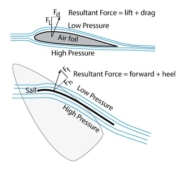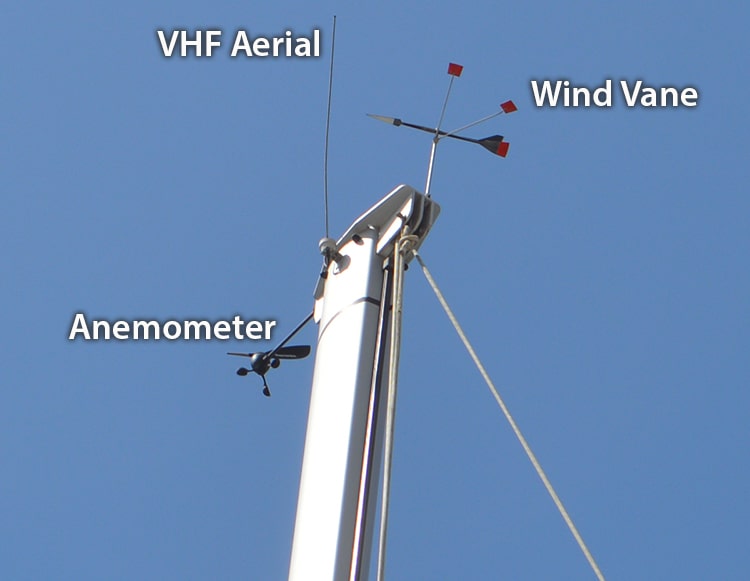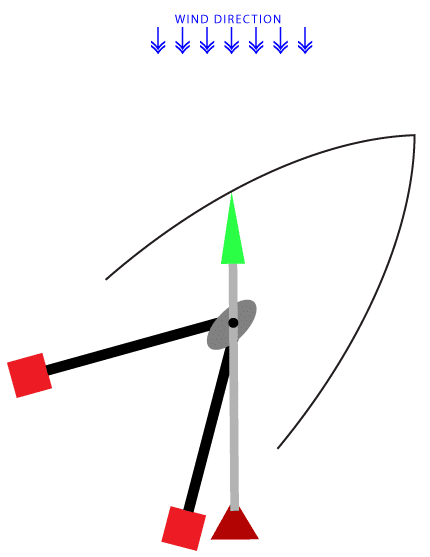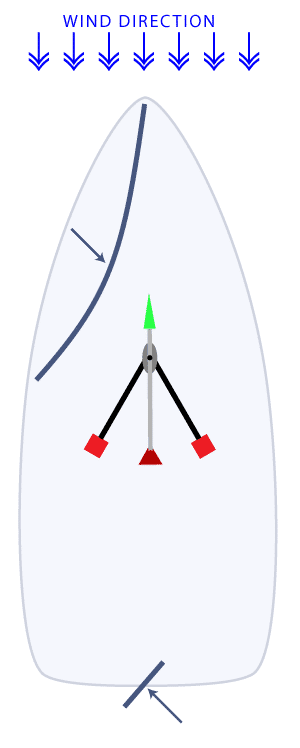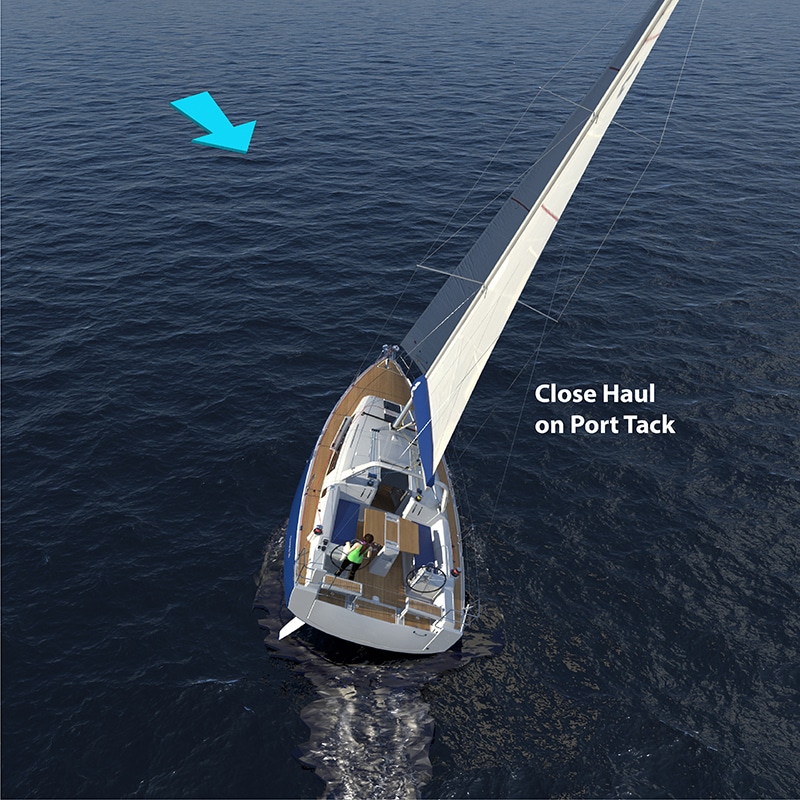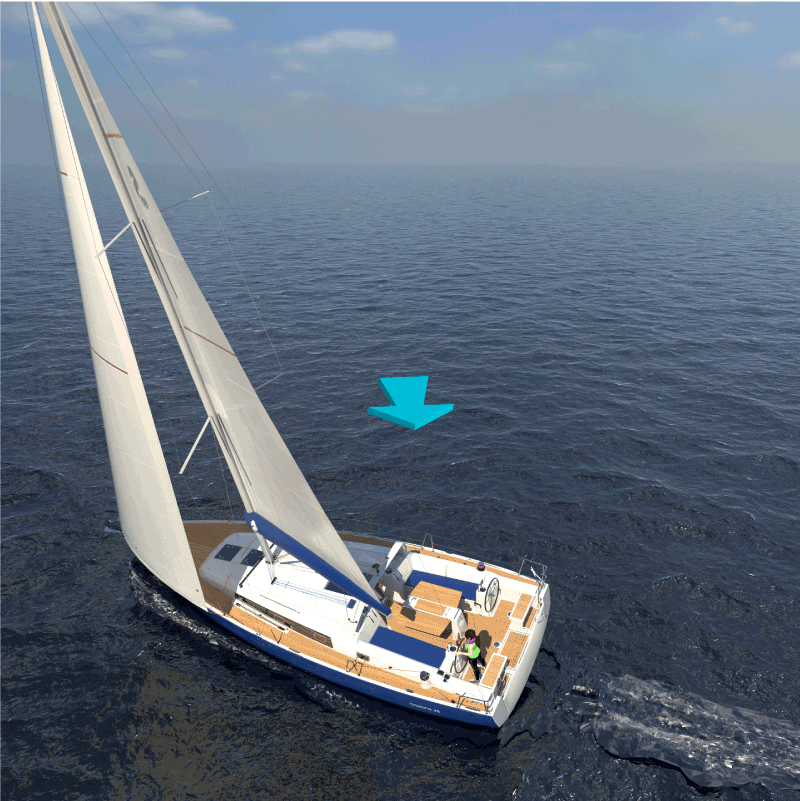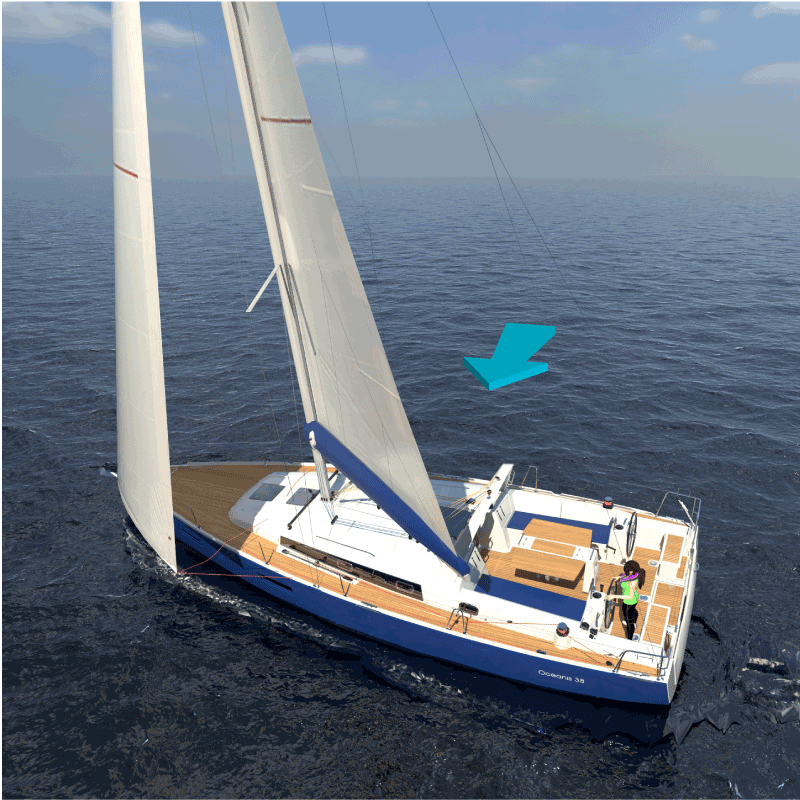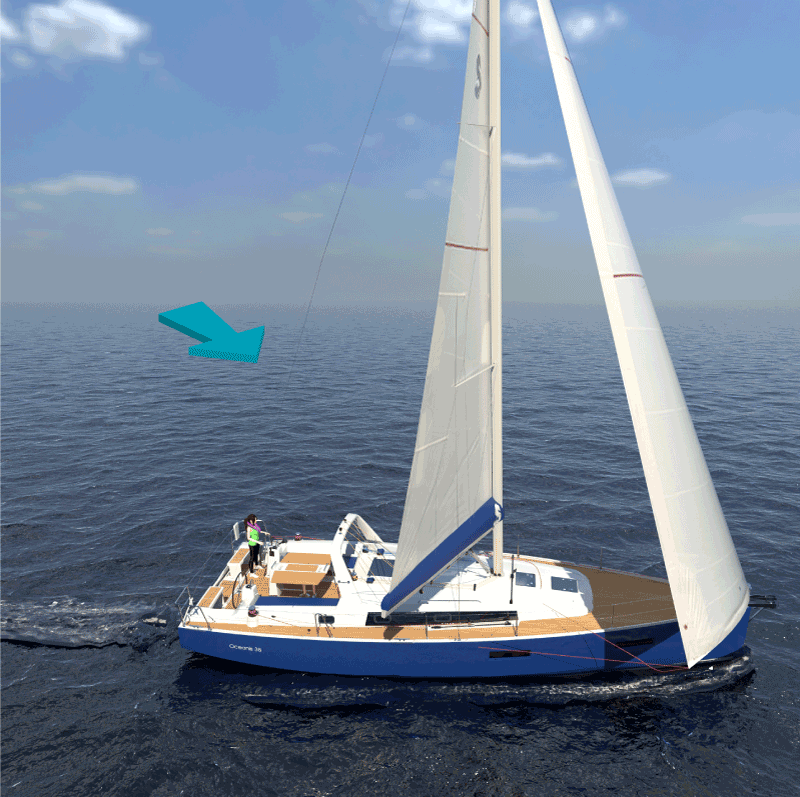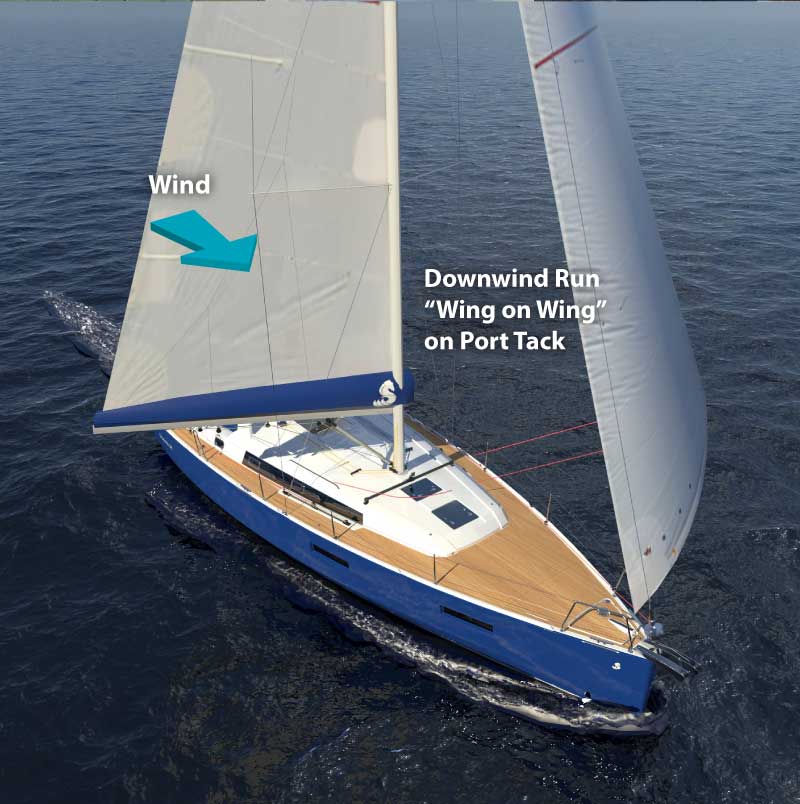Sailing and Wind Forces
A sailboat moves in upwind and downwind directions. Downwind is intuitive; it just gets blown downwind. But just how does a sailboat move into the wind? To understand how a sailboat moves, let’s think about an airplane wing. Most of us know that a plane lifts off the ground because the wings provide lift. It does this in the following manner: The wind moving across the top of the wing has farther to travel and thus must move faster. According to some mathematical equation (who cares; but it is Bernoulli’s Equation in case you really want to know) faster-moving air has lower pressure. A wing with low pressure on the top side and higher pressure on the bottom side will move up thereby dragging the plane and passengers with it.
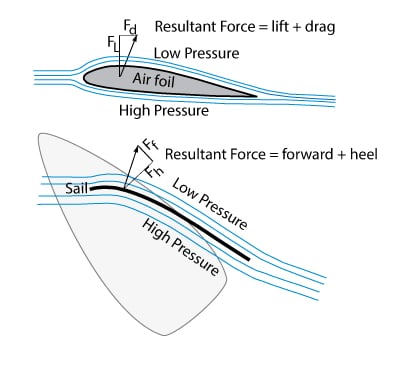
Airfoil and Sail
The interesting point on this is that the wind pressure on the sail helps make the shape of the sail like a wing.
Another comparison can be made with a hair dryer. Rather than make you take out a hair dryer to see the effect of fast-moving air creating low pressure, here is an animation of exactly what happens. Turn on the hair dryer.
Hair Dryer Animation
When sailing, a sail is just a vertical wing. Instead of lifting the sailboat up to the sky, it lifts the sailboat forward upwind. It can’t be any other way. If the wind was always just pushing on the sails, how could the wind push the boat in an upwind direction?
Wing and a Sail
Wind Vane
Just like a speedometer on your car, your boat has an instrument you must check often (very often) to see how you are doing in relation to the wind. Over-speed in your car at the wrong place and you get a ticket. Sail at a non-optimal sail set with respect to the wind and your crew is going to admonish you. If you’re racing and you are the sail trimmer or helmsperson, you’re going to get a tongue-lashing from the tactician.
You will be checking this instrument every 4 to 10 seconds depending on what the wind is doing—varying, gusting, changing direction: veering (changing clockwise) or backing (changing counterclockwise).
Here it is—it’s called a wind vane. It sits on top of the mast and points to where the wind is coming from.
A Wind Vane at the Top of the Mast
Looking directly down onto the wind vane from the sky, if you are pointing directly into the wind it will look like the drawing below.
Head to Wind
Sailing at 45 Degrees
The arrow always points to the direction of the apparent wind. The two bright red tails are stationary and indicate that if the darker red tail of your arrow is in this zone you are sailing too close into the wind. You can only sail your boat efficiently if the red tail of the arrow is outside the two red stationary tabs.
Now hear this: Just like steering your car, you would NOT keep looking at your speedometer while you accelerated to 60 miles per hour (100km/hr). You’d be off the road in a ditch. What you do is glance at your speedometer for 1/2 second or so as you approach your target speed.
The same principle applies: DO NOT look at your wind vane for any longer than 1/2 second each time. Keep your eyes on the water and land so that you are sailing in a straight line. When you want to make a direction adjustment, check the wind vane first (1/2 second), then bring your eyes back to the land. Now make a relative adjustment to the land and then check your wind vane for 1/2 second to see if you made the correct adjustment. Repeat if necessary. You simply cannot make direction adjustments while looking at the wind vane. You will overshoot your mark EVERY time no matter how experienced you are.
Because every novice makes this mistake, we will just repeat it. DO NOT look at your wind vane for any longer than 1/2 second and do not watch the wind vane while you are making direction changes. Just don’t do it: EVER.
Points of Sail (Sailing Angles)
Points of Sail is a term used to describe the angle the boat is headed relative to the wind. The more descriptive term is Sailing Angles. Initially, as a novice, it is not that easy for you to determine; but it becomes easier with experience. At all times, you must know your Point of Sail (Sailing Angle) because this determines how you set your sails.
Novices can tell you that the wind is coming from the left side of the boat or the right side. But if you ask them to state the angle relative to the boat, they clam up. That’s okay—this is all new.
Fortunately, the wind vane tells you almost exactly what is going on at all times. And now, armed with the knowledge of the wind angle and thus the Sailing Angle, you can set your sails almost perfectly.
For every angle to the wind you wish to sail, there is a name for that heading. These names relate to the angle the wind hits your vessel and each has its own distinct personality and characteristics due to wind factors. Words like broad reach, beam reach, close reach, close haul, and running are quite intuitive and will soon become part of your nautical lingo.
Below is an interactive diagram depicting the names of the “Sailing Angles” of a sailboat. Hoover over (tap for mobile) each boat and see the name of the Sailing Angle popup. Use the diagram to try to help memorize those names. The number is the o’clock angle the boat is pointing relative to the wind where 12 o’clock is directly into the wind and 6 o’clock is directly away from the wind. You will also learn that you can not “sail” anywhere between 11 and 1 o’clock because it is too much directly into the wind. This is called the “no-go-zone”.
Points of Sail – Sailing Angles
Also, note that sometimes some sailors will refer to a close haul as a “beat.” This term probably originates from the old Norse language “beita upp í vindinn” = “apply to the wind” which was shortened to “beita” and then into English “beat”. A beat is relevant and easy to remember because it is the sailing angle where the wind feels the strongest and you will hit the oncoming waves the hardest – you will be “beat” up at the end of a long sail.
Now watch the video of a sailboat as it sails around a course. Try to keep up with the sailing angle names as they move quickly around.
Sailing a Course Video
The animation below helps you see what the wind vane is doing and how the sail should be set for each Point of Sail. Tap on any and all of the Points of Sail and you will see what is happening. Start with a close haul on starboard.
Point of Sail Animation
Head to Wind
Head-to-wind means your boat is headed directly into the wind. The sails are “luffing” or “flogging” back and forth and the jib sheets are whipping dangerously. The boat is not moving and you’re basically stuck. It’s called “stuck in irons.”
To get out of “irons,” tighten up on the headsail sheet to one side. Turn the rudder so the tiller is parallel to the headsail. Since the boat will begin to go backward slightly, both the sail and rudder act in unison to turn the boat. In the image below the boat will turn clockwise.
Getting Out of Irons
Pinching
Pinching means you are still sort of sailing but not really very efficiently. You’re heading too close to the wind yet there is still some minor force from the wind that is propelling you forward. The angle is too close to the wind to create any sail shape. Your speed will be extremely slow and the sails are lightly luffing. The front of the sail is collapsed in on itself and is considered “backwinded.” To get out of this, bear away from the wind until the wind vane arrow tail matches one of the stationary tails; a close haul.
Close Hauled
Close hauled means the wind is as close to the bow as possible while still being able to provide efficient sail power, about 30-45 degrees off the bow. The boat below is on a port tack because the wind is coming from the port (left) side of the boat.
- Sails are sheeted in as tight as possible
- Boom is positioned at about the vessel’s centerline
- Boom vang is tight
- Headsail should be close to, but not touch, the spreaders
- As the vessel heels, there is a slight weather helm* on the tiller, and you feel lots of wind in your face
- Telltales* are streaming back on both windward and leeward sides
*more on weather helm and telltales soon
Close Haul
Close Reach
With close reach, the wind is a bit farther around toward the side of the boat than a close-hauled point of sail, somewhere between 50 to 75 degrees off the bow.
- Sails are eased more than close-hauled
- The main boom is off centerline and the headsail is not as tight
- The boom vang can be eased to help fly the top telltales
- The vessel heels but not excessively
- Telltales streaming smoothly on both windward and leeward sides
Close Reach
Beam Reach
On a beam reach, the wind angle is approximately 90 degrees off the bow; across the beam of the boat. It is a very efficient point of sail.
- The sails are eased further, seemingly almost all the way out
- The main boom extends over the side of the vessel. The spreaders may just begin to indent the mainsail. This should be monitored carefully to prevent chafing
- The headsail telltales will follow the curve of the sail on both windward and leeward sides
- The boom vang can be eased further to allow the mainsail to twist out at the top
Many sailors tend to oversheet the sails on a beam reach; let it out. Oversheet means you have pulled in the sheet too far for an efficient set of sail.
On a beam reach, the vessel is relatively flat and has excellent speed.
Beam Reach
Broad Reach and the Deep Broad Reach
On a broad reach, the wind angle is 120 degrees or so off the bow. On a deep broad reach, the wind angle is 150 degrees or so off the bow.
At anything more than about 140 degrees off the wind, you are being pushed by the wind. You no longer have a lift to contend with so the telltales are not going to give you much information.
- The traveler can be eased down to leeward
- The boom vang can be adjusted to help the top of the mainsail be perpendicular to the wind
- At this position, the vessel is simply being pushed by the wind
- The apparent wind decreases so furled reefed sails can possibly be unreefed
- The outhaul and cunningham can be eased to create bagginess to the sail. Don’t do this in high wind conditions
- The luff of the headsail may curl forward of the vessel’s forestay
- The broad reach and deep reach are very comfortable points of sail
Broad and Deep Broad Reach (on port)
For downwind sailing angles, there are many special sails available to capture more wind. The most noticeable being the spinnaker and gennaker. These huge colorful and billowy sails capture lots of wind for fast sailing. A spinnaker is used for deep broad reaches through direct downwind angles. It blows way out the front of the boat and uses a pole to windward to stabilize it. A gennaker is sometimes called an asymmetric spinnaker. It is a larger headsail made of light sail material used for sailing in downwind angles from a beam reach to a deep broad reach. It does not do well in a direct downwind point of sail.
A furling gennaker is used as the head sail while the jib is furled (rolled in around the forestay)
Running Downwind
The final Point of Sail is when the wind is directly behind the sailboat. This is called running downwind. Now the mainsail totally blankets the headsail. The mainsail can be let out to its maximum, but be aware of spreader interference.
On this heading, there is no lift on the sails. The headsail can now be positioned on the opposite side of the main. This configuration is called “wing and wing.” Sometimes a “whisker pole” is used to hold the headsail out from the mast. More often however in a race, the headsail is doused and the spinnaker is used.
Running directly downwind with sails positioned on opposite sides can be a little dangerous because, without constant attention, the mainsail and thus the VERY HARD boom can gybe across and injure a crew member. Besides this, there is not too much advantage to heading directly downwind even if your destination is downwind. You’ll find that gaining some apparent wind by coming back up to between 140 and 160 degrees gives extra boat speed. Heading off your downwind direction will require you to gybe back and forth, however, the extra boat speed over-accounts for this. For this reason, you seldom see a professional sailing directly downwind.
Running Downwind
Sail Set for Each Sailing Angle (Point of Sail)
Now view the sail set animation again to see how the sails should be set for all the Points of Sail.
If you merely follow the set of sails shown in this animation for each Point of Sail, you will probably be sailing better than 90 percent of sailors out there, unless they have taken this course. Finer settings of the sails come from the finesse of sail trim skill whereby you make small adjustments based on telltales and “just a feeling.”


